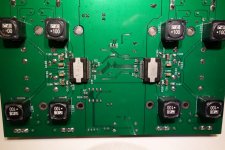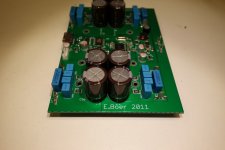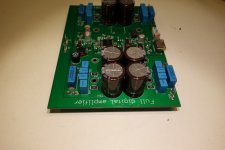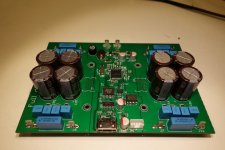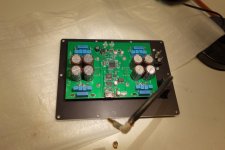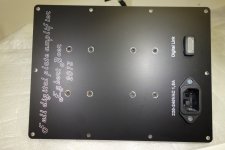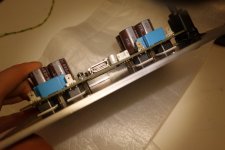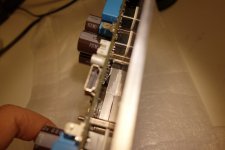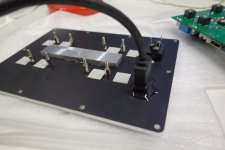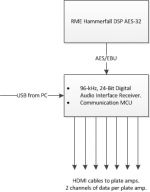I'm developing a plate amp that uses I2S over a HDMI cable to transport the audio digitally to your speakers.
To keep things simple it does not have any HMI.
The amp will be controlled on the master side.
I want to use a USB 2.0 to 8 channels i2s to feed the plate amps with audio.
Then i want to use a usb connected PIC with a i2c multiplexer to communicate with the plate amps and set the bi-quids and volume.
Delays needs to be done on the computer as the DDX8001 does not support this.
Any one interested?
To keep things simple it does not have any HMI.
The amp will be controlled on the master side.
I want to use a USB 2.0 to 8 channels i2s to feed the plate amps with audio.
Then i want to use a usb connected PIC with a i2c multiplexer to communicate with the plate amps and set the bi-quids and volume.
Delays needs to be done on the computer as the DDX8001 does not support this.
Any one interested?
Attachments
Although nobody seems to be interested, i have finished this device with great success. Here are the pictures. 
The I2S and I2C are generated by a Xmos sx1-l2 device (8 channel). The PCB is underdevelopment.
I have replaced the DDX8001 with a STA308a but this device produced to much noice.
Then I replaced the device with the TAS5508c, I also integrated PSCV in the design.
I used a meanwell 150W 48V power supply and modified it to accept PSCV, the supply is controlled between 12 - 60V.
The amp is ultra low noise although i do not have the instruments to do measurements.
The I2S and I2C are generated by a Xmos sx1-l2 device (8 channel). The PCB is underdevelopment.
I have replaced the DDX8001 with a STA308a but this device produced to much noice.
Then I replaced the device with the TAS5508c, I also integrated PSCV in the design.
I used a meanwell 150W 48V power supply and modified it to accept PSCV, the supply is controlled between 12 - 60V.
The amp is ultra low noise although i do not have the instruments to do measurements.
Attachments
Last edited:
Thank you for your kind reply. 
I assembled the 6mm thick aluminium plate today, the plates are made in Germany by Protopanel.
I assembled the 6mm thick aluminium plate today, the plates are made in Germany by Protopanel.
Attachments
To control the amp; I have started a tread here: [diy] Another USB to multichannel I2S with I2C ?
Hi egberttheone,
I would be very interested in an audio power amplifier, that could take AES/EBU signals for input. For example, such amplifier could be driven directly by RME Hammerfall DSP AES-32, see:
RME: Hammerfall DSP AES-32
Can you do it?.
Best Regards,
Bohdan
I would be very interested in an audio power amplifier, that could take AES/EBU signals for input. For example, such amplifier could be driven directly by RME Hammerfall DSP AES-32, see:
RME: Hammerfall DSP AES-32
Can you do it?.
Best Regards,
Bohdan
That is possible; the only thing is that there are no PWM processors that can process this signal directly. This transport medium is also not made for low jitter (as far as I know).
You can easily translate AES3 to i2s.
Just out of curiosity: why would you like to have a DSP in front of your amp?
My plate amp has an on-board DSP.
You can easily translate AES3 to i2s.
Just out of curiosity: why would you like to have a DSP in front of your amp?
My plate amp has an on-board DSP.
Hi,
Thank you for your response.
I need a digital sound card to use with Linear-phase DSP PC software.
It's called Ultimate Equalizer, please see the detailed description - Bodzio Software
I processes 8 channels in and 16 channels out with 32k FFTs (partitioned convolution) at 96kHz, so typical DSP just does not have the processing power for this - as far as I know.
Anyway, are you in the position to develop a prototype?.
I am seriously interested to cooperate/support.
Best Regards,
Bohdan
Thank you for your response.
I need a digital sound card to use with Linear-phase DSP PC software.
It's called Ultimate Equalizer, please see the detailed description - Bodzio Software
I processes 8 channels in and 16 channels out with 32k FFTs (partitioned convolution) at 96kHz, so typical DSP just does not have the processing power for this - as far as I know.
Anyway, are you in the position to develop a prototype?.
I am seriously interested to cooperate/support.
Best Regards,
Bohdan
The processor (TAS5508c) has 7 biquads before every channel to do some DSP to the signal.
It is possible however to add 8 input channels (analog or digital) to the Xmos usb design.
(the signals can then be processed on the PC)
Or do you seriously need a amp that runs AES3 because then you have to make a separate communication line to do the control of the TAS5508c, and write costume software for that.
It is possible however to add 8 input channels (analog or digital) to the Xmos usb design.
(the signals can then be processed on the PC)
Or do you seriously need a amp that runs AES3 because then you have to make a separate communication line to do the control of the TAS5508c, and write costume software for that.
Hi,
If you have a DSP device, that can process impulse response of 32k coefficients length (actually, 64k for future UE releases) under 160ms, then I am happy to use it. Obviously, it would have to process 16 such channels.
Otherwise, I'll stick with analogue sound cards. Contemporary sound cards and motherboards (such as ALC1150 codec), offer better than 110dB SNR, so it's all good.
Best Regards,
Bohdan
If you have a DSP device, that can process impulse response of 32k coefficients length (actually, 64k for future UE releases) under 160ms, then I am happy to use it. Obviously, it would have to process 16 such channels.
Otherwise, I'll stick with analogue sound cards. Contemporary sound cards and motherboards (such as ALC1150 codec), offer better than 110dB SNR, so it's all good.
Best Regards,
Bohdan
Alright, the simplest solution would be to use the plate amp as it is.
As it is tested and is functional already.
To connect the plate amp to AES/EBU, you need to translate the signal to I2S.
I would suggest to translate all the AES/EBU (16 channel) to I2S (8 data channels) on one PCB and send the over HDMI cables to the plate amps. This would only require one master clock(crystal).
The DIR9001 can decode the biphase signal format which is specified in one of the following standards.
Generally, these following standards may be called Sony/Philips digital interface format (S/PDIF) or AES/EBU.
• IEC60958 (revised edition of former IEC958)
• JEITA CPR-1205 (revised edition of former EIAJ CP-1201, CP-340)
• AES3
• EBU tech3250
The sampling frequency range and data word length which DIR9001 can decode is as follows:
• Sampling frequency range is 28 kHz to 108 kHz.
• Maximum audio sample word length is 24-bit.
Tell me what you think.
As it is tested and is functional already.
To connect the plate amp to AES/EBU, you need to translate the signal to I2S.
I would suggest to translate all the AES/EBU (16 channel) to I2S (8 data channels) on one PCB and send the over HDMI cables to the plate amps. This would only require one master clock(crystal).
The DIR9001 can decode the biphase signal format which is specified in one of the following standards.
Generally, these following standards may be called Sony/Philips digital interface format (S/PDIF) or AES/EBU.
• IEC60958 (revised edition of former IEC958)
• JEITA CPR-1205 (revised edition of former EIAJ CP-1201, CP-340)
• AES3
• EBU tech3250
The sampling frequency range and data word length which DIR9001 can decode is as follows:
• Sampling frequency range is 28 kHz to 108 kHz.
• Maximum audio sample word length is 24-bit.
Tell me what you think.
Attachments
Hi,
I am sorry for late response, just very busy here.
If I understand you correctly, you propose to perform the following conversions: AES/EBU -> I2S -> D/A -> analogue power amplifier
After reading http://www.analog.com/static/imported-files/application_notes/TN_21065L_I2S.pdf
Would it be possible to perform direct: AES/EBU -> D/A -> -> analogue power amplifier.
The idea here is to come up with a commercial, single, small PCB, that anybody with an analogue audio amplifier could purchase from you and install inside his/her amplifier, and just plug it into the RME Hammerfall DSP AES-32 output. This would in fact create an AES/EBU power amplifier.
Since AES/EBU is primarily for 2 channels, the PCB board would ideally decode two channels to analogue.
Does this make sense?.
Best Regards,
Bohdan
I am sorry for late response, just very busy here.
If I understand you correctly, you propose to perform the following conversions: AES/EBU -> I2S -> D/A -> analogue power amplifier
After reading http://www.analog.com/static/imported-files/application_notes/TN_21065L_I2S.pdf
Would it be possible to perform direct: AES/EBU -> D/A -> -> analogue power amplifier.
The idea here is to come up with a commercial, single, small PCB, that anybody with an analogue audio amplifier could purchase from you and install inside his/her amplifier, and just plug it into the RME Hammerfall DSP AES-32 output. This would in fact create an AES/EBU power amplifier.
Since AES/EBU is primarily for 2 channels, the PCB board would ideally decode two channels to analogue.
Does this make sense?.
Best Regards,
Bohdan
Hi,
Would it be possible to perform direct: AES/EBU -> D/A -> -> analogue power amplifier.
The idea here is to come up with a commercial, single, small PCB, that anybody with an analogue audio amplifier could purchase from you and install inside his/her amplifier, and just plug it into the RME Hammerfall DSP AES-32 output. This would in fact create an AES/EBU power amplifier.
Best Regards,
Bohdan
Don't you think that AES/EBU is unnecessary (and not free) part here in this chain as topic starter offers more flexible and convenient (nowadays) XMOS USB?
Regards,
Konstantin
Don't you think that AES/EBU is unnecessary (and not free) part here in this chain as topic starter offers more flexible and convenient (nowadays) XMOS USB?
Regards,
Konstantin
Hi Konstantin,
AES/EBU is considered to be the standard protocol for professional audio applications – USB is not. So from this angle, I am not re-inventing the wheel.
I am simply exploring a feasibility of one particular option.
If this proves to be feasible, it would be possible to have a digital link between HTPC (which does all DSP processing) and power amplifiers, thus eliminating the potential of ground loops and obviously providing full digital link, right up to the power amplifier.
Secondly, it’s a very neat solution, as you would only need a “good looking” HTPC and a couple of multi-channel amplifiers.
For your information, AES/EBU – to - analogue and back converters already exist, see: Analog to AES/EBU However, this is an extra separate box, that goes between RME Hammerfall DSP AES-32, or Lynx AES16 sound card and the audio amplifier.
Developing AES/EBU audio power amplifiers would be far neater solution. If it's not possible, I can use the Mamba converters, or stay with analogue paths, as I do now.
Best Regards,
Bohdan
Don't you think that AES/EBU is unnecessary (and not free) part here in this chain as topic starter offers more flexible and convenient (nowadays) XMOS USB?
Regards,
Konstantin
I forgot to add a link to a commercial AES/EBU audio power amplifier:
http://www.dbaudio.com/fileadmin/docbase/TI315_1.0EN.PDF
This is what we are looking for, but DYI, cost effective version.
Can this be done?.
Best Regards,
Bohdan
This can be done yes, but will take a lot of time and money to develop.
Only when there is a high demand for this application it is cost effective to take the time to develop.
You have to understand that although USB is not yet recognized as a high end audio transport, it is better then the commercial jittery AES/EBU.
My HTPC is a really small device, it only needs USB. you need a huge DSP (expensive) card; from my understanding the DSP is done by the processor and not on the DSP card it self?
So why not use USB instead?
conclusion: Without money or a market i can help you advise but not on the development.
Only when there is a high demand for this application it is cost effective to take the time to develop.
You have to understand that although USB is not yet recognized as a high end audio transport, it is better then the commercial jittery AES/EBU.
My HTPC is a really small device, it only needs USB. you need a huge DSP (expensive) card; from my understanding the DSP is done by the processor and not on the DSP card it self?
So why not use USB instead?
conclusion: Without money or a market i can help you advise but not on the development.
This can be done yes, but will take a lot of time and money to develop.
Only when there is a high demand for this application it is cost effective to take the time to develop.
You have to understand that although USB is not yet recognized as a high end audio transport, it is better then the commercial jittery AES/EBU.
My HTPC is a really small device, it only needs USB. you need a huge DSP (expensive) card; from my understanding the DSP is done by the processor and not on the DSP card it self?
So why not use USB instead?
conclusion: Without money or a market i can help you advise but not on the development.
Hi,
I am developing a feeling, that you have misunderstood the requirements.
I have provided you with pointers to Mamba converters and DE12 amplifier, to show you, that devices like this already exist on the market.
I do not want any DSP processing on your PCB. All DSP processing is done by UltimateEqualizer and the results are send to RME Hammerfall DSP AES-32, or Lynx AES16 sound card.
So, all that I was asking for is a simple AES/EBU – to - analogue converter.
Anyway, I expected this. Thanks anyway.
Best Regards,
Bohdan
Hi Bogdan,
I got your point.
But from the point of view of end consumer your offer is less attractive. The quality is worse - one more signal conversion with higher jitter (if USB interface is implemented correctly), the price is higher.
The fact that AES/EBU - is a professional interface in contrast to USB doesn't mean a lot for diyers. The main things are quality, price and consumer properties.
Of course, it is only my opinion.
Regards,
Konstantin
I got your point.
But from the point of view of end consumer your offer is less attractive. The quality is worse - one more signal conversion with higher jitter (if USB interface is implemented correctly), the price is higher.
The fact that AES/EBU - is a professional interface in contrast to USB doesn't mean a lot for diyers. The main things are quality, price and consumer properties.
Of course, it is only my opinion.
Regards,
Konstantin
- Status
- This old topic is closed. If you want to reopen this topic, contact a moderator using the "Report Post" button.
- Home
- Source & Line
- PC Based
- PC controlled full digital plate amp

